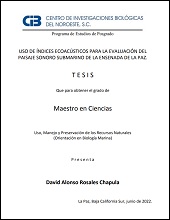| dc.contributor.advisor | Romero Vivas, Eduardo | |
| dc.contributor.author | Rosales Chapula, David Alonso | |
| dc.date.issued | 2022 | |
| dc.identifier | https://cibnor.repositorioinstitucional.mx/jspui/handle/1001/2657 | |
| dc.identifier.uri | http://dspace.cibnor.mx:8080/handle/123456789/3120 | |
| dc.description.abstract | "Los ambientes lagunares como la Ensenada de La Paz, México, son ecotonos únicos de gran relevancia ecológica que presentan una gran variedad de sonidos generados por los factores biológicos, geofísicos y antropogénicos. Estos sonidos están integrados a su entorno natural, la suma de dichos sonidos forma el ambiente sonoro; al describir e interpretar sus componentes acústicos se obtiene el paisaje sonoro, que para estudiarlo se ha propuesto el uso de los índices ecoacústicos, sin embargo, al ser desarrollados para ambientes terrestres, su uso en ambientes marinos ha sido limitado y no completamente validado. A partir de una revisión bibliográfica y con base en su uso y eficacia en ambientes costeros, se seleccionaron cuatro índices ecoacústicos: el índice de complejidad acústica (ACI), el índice de entropía acústica (AEI), el índice bioacústico (BI), y el índice diferencial normalizado del paisaje sonoro (NDSI), empleados para caracterizar el ambiente sonoro submarino de la Ensenada de La Paz y con ello conformar el paisaje sonoro. Se utilizaron dos grabaciones de 20:01:34 h realizadas en el mes de julio de 2018, una en el canal de entrada (B19) el día 14 y otra en el interior de la Ensenada (B29) el 17, ambas a 3 m de profundidad. Se clasificaron y cuantificaron los distintos eventos acústicos de acuerdo con su fuente en tres categorías: biofonías, antropofonías y geofonías, de forma visual y auditiva mediante una anotación de referencia, apoyados de espectrogramas en catálogos y por registros en fuentes externas. Los valores obtenidos de los índices (MATLAB y R) se validaron respecto a la anotación y utilizando una correlación biserial puntual. El análisis demuestra que los tres tipos de eventos sonoros considerados tuvieron mayor presencia en la estación B29, donde las biofonías estuvieron un 97.5% del tiempo en el interior y un 20.67% en la entrada, las antropofonías un 59.73% y 25.26%, y las geofonías un 21.42% y 16.22%, demostrando así que las biofonías son el componente principal del interior y las antropofonías de la entrada. Los valores dados por los índices fueron mayores en la B19 (AEI=0.925/0.91, BI=4.5/4.4, NDSI=0.92/0.8), excepto por el ACI (ACI=185/220)..." | es |
| dc.format | pdf | es |
| dc.language.iso | spa | es |
| dc.publisher | Centro de Investigaciones Biológicas del Noroeste, S.C. | es |
| dc.rights | Acceso abierto | es |
| dc.subject | sonido, ecosistema estuarino, diversidad | es |
| dc.subject | sound, estuarine ecosystem, diversity | es |
| dc.subject.classification | DISPOSITIVOS DE SONAR | es |
| dc.title | Uso de índices ecoacústicos para la evaluación del paisaje sonoro submarino de la Ensenada de La Paz | es |
| dc.type | masterThesis | es |
| dc.dirtesis.grado | Maestría en Ciencias en el Uso, Manejo y Preservación de los Recursos Naturales | es |
| dc.dirtesis.disciplina | Biología Marina | es |
| dc.dirtesis.universidad | Centro de Investigaciones Biológicas del Noroeste, S.C. | es |
| dc.dirtesis.facultad | Posgrado en Recursos Naturales | es |
| dc.description.abstracten | "Lagoon environments such as Ensenada de La Paz, Mexico, are unique ecotones with great ecological relevance, presenting a wide variety of sounds generated by biological, geophysical and anthropogenic factors. These are integrated within their natural environment, and together form the acoustic environment; when its acoustic components are described and interpreted the soundscape is obtained, and in order to study it, the use of ecoacoustic indices has been proposed, however, these were developed for terrestrial environments, so their use in marine environments has been limited and not completely validated. After a literature review and based in their use and efficiency in coastal environments, four ecoacoustic indices were chosen: the acoustic complexity index (ACI), the acoustic entropy index (AEI), the bioacoustic index (BI), and the normalized difference soundscape index (NDSI), implemented to characterize the Ensenada de La Paz underwater acoustic environment and thereby shape the soundscape. Two 20:01:34 h recordings from July 2018 were used, one of them at the Ensenada’s entrance channel (B19) on day 14th, and the other one at the interior (B29) on day 17th, both at 3 m deep. The different acoustic events were classified and quantified according to their source in three categories: biophonies, anthropophonies and geophonies, visually and aurally in a reference annotation, supported by spectrograms in catalogs and external sources recordings. Obtained indices values (MATLAB and R) were validated against the annotation and using a point biserial connection. Analysis shows that the three considered types of acoustic events had a greater presence at station B29, where biophonies were 97.5% of the time at the interior and 20.67% at the entrance, anthropophonies a 59.73% and 25.26%, and geophonies a 21.42% and 16.22%, demonstrating that biophonies are the main component at the interior and anthropophonies at the entrance. Indices values were higher at B19 (AEI=0.925/0.91, BI=4.5/4.4, NDSI=0.92/0.8), except for the ACI (ACI=185/220). The highest correlations occurred for biophonies with the four indices in both stations, except for the anthropophonies at B29 with the NDSI (b=0.3964, a=-0.4079), while geophonies had the lowest correlations in all cases, with the exception of anthropophonies at B19 with the ACI (a=0.2781, g=0.4404) and NDSI (a=-0.0749, g=0.0995)..." | es |

